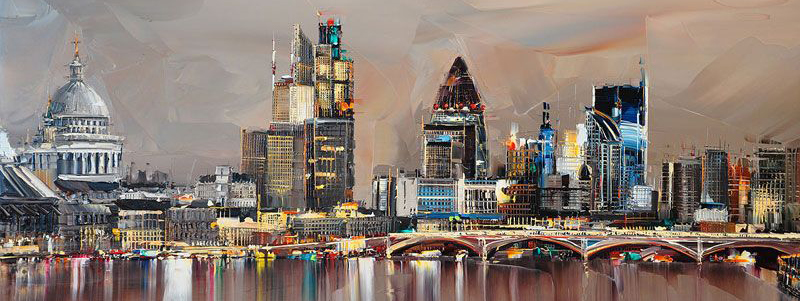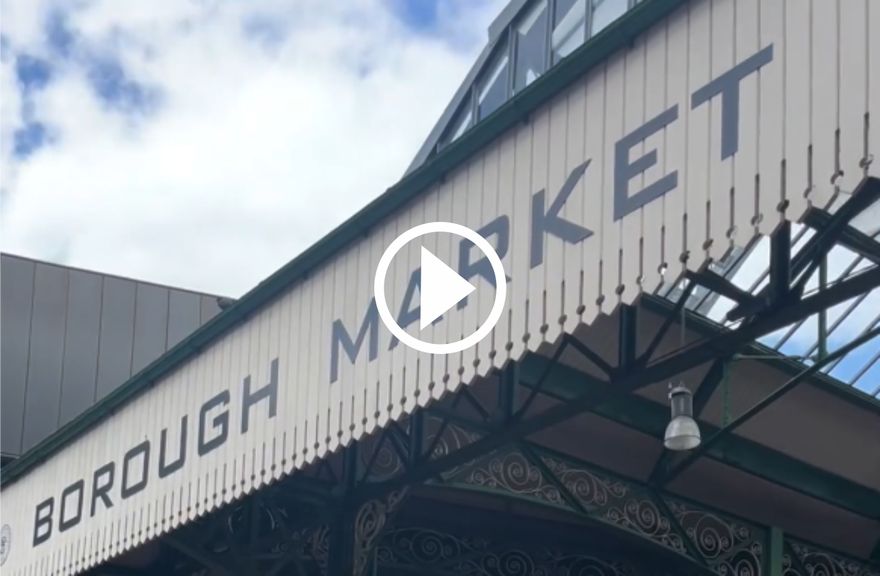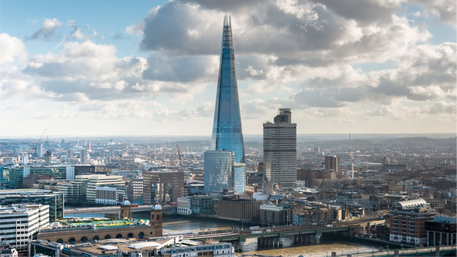 The name comes from that of Suthgeweork, in use in the 11th century, when it meant "fortification of the south". It indicated the defensive function of the bridgehead to protect the City, in the days when the London Bridge was its only access. The Southwark area is shaped like an isosceles triangle with its base on the river bank. The northern part is more densely populated, the south is more green and has a large golf course. At the site of the Tate Modern, which occupies a power plant building, the ground is low. Towards Dulwich, however, it is higher and reaches the highest point at Christal Palace.
The name comes from that of Suthgeweork, in use in the 11th century, when it meant "fortification of the south". It indicated the defensive function of the bridgehead to protect the City, in the days when the London Bridge was its only access. The Southwark area is shaped like an isosceles triangle with its base on the river bank. The northern part is more densely populated, the south is more green and has a large golf course. At the site of the Tate Modern, which occupies a power plant building, the ground is low. Towards Dulwich, however, it is higher and reaches the highest point at Christal Palace.Southwark contends with the City for the primacy of oldest town. There was already a Roman settlement here and in the south transept of its cathedral, a fragment of mosaic from that time is preserved. Also in the river were found Roman finds, including a trident, which was part of the soldiers' equipment, and a wine jar, with the inscription "Londoni ad Fanum Isidis" ("London to the temple of Isis"). All these finds are on display at the London Museum. In such an ancient and rich in history district even the names of the streets have a special interest. The short alley of Cardinal Cap Alley reminds us that this land was once owned by the Church. The nearby Rose Alley is reminiscent of the theatre of the same name, opened in 1587. In Hopton Street there are the twenty-six pretty Hopton cottages, built around two lawns with rose beds in the middle and hedges on all four sides. They were made in 1752 by the will of the fishmonger Charles Hopton and were intended for the boatmen and poor fishermen of the parish, who were also given some money and coal for the winter.
Outside the cottages there is a fountain and watering hole. Southwark’s main street is Borough High Street. Along this road there were more than twenty inns with large courtyards and porticoes all around, active until the arrival of the railway.
SOUTHWARK CATHEDRAL
LONDON BRIDGE
METRO: LONDON BRIDGE
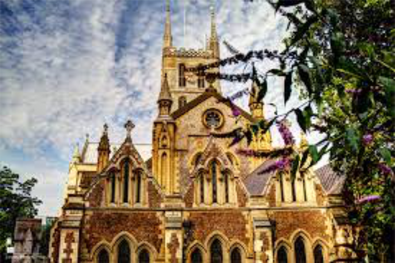 The cathedral’s real name, which together with Lambeth Palace is the most important medieval building in south London, is that of St Saviour and St Mary Overie church. The word overie means "on the river bank". In 1106, the Augustinian monks lived here in a large stone monastery with an adjoining church. In 1206, the latter was destroyed by a fire, from which only the choir and ambulatory were saved. It was two centuries before the building was rebuilt; in the current one there are many architectural overlaps over the centuries, but despite this, the general appearance is homogeneous and harmonious. Next to the choir is a wooden statue of a crusader, from 1270. It is one of the very few of its kind left in the country and the details of the armor and the whisk maintain a remarkable freshness. In the northwest corner are the remains of the 15th century wooden ceiling, decorated with flowers and carved leaves. There is also the figure of a pelican sucking blood from the chest to give it to the babies, placed near a devil swallowing Judas Iscariot. The magnificent transenna between the nave and the choir is from 1520. In the nineteenth century, the nave was replaced by a neo-Gothic structure and in 1897 an organ was installed, built by T. Lewis, still used for lunchtime concerts.
The cathedral’s real name, which together with Lambeth Palace is the most important medieval building in south London, is that of St Saviour and St Mary Overie church. The word overie means "on the river bank". In 1106, the Augustinian monks lived here in a large stone monastery with an adjoining church. In 1206, the latter was destroyed by a fire, from which only the choir and ambulatory were saved. It was two centuries before the building was rebuilt; in the current one there are many architectural overlaps over the centuries, but despite this, the general appearance is homogeneous and harmonious. Next to the choir is a wooden statue of a crusader, from 1270. It is one of the very few of its kind left in the country and the details of the armor and the whisk maintain a remarkable freshness. In the northwest corner are the remains of the 15th century wooden ceiling, decorated with flowers and carved leaves. There is also the figure of a pelican sucking blood from the chest to give it to the babies, placed near a devil swallowing Judas Iscariot. The magnificent transenna between the nave and the choir is from 1520. In the nineteenth century, the nave was replaced by a neo-Gothic structure and in 1897 an organ was installed, built by T. Lewis, still used for lunchtime concerts.Next to the main entrance, on the south-west side, there is the baptismal font with a very elaborate lid and, nearby, a monument dedicated to William Shakespeare, executed by H. McCarthy in 1912. The playwright is depicted in a reclining position and around him are the houses of Southwark, of tiny proportions.
WINCHESTER PACACE
CLINK STREET
METRO: LONDON
The palace was the London residence of the Bishop of Winchester. It stood south of the River Thames, west of the London Bridge and less than two hundred metres from Southwark Cathedral, on the site of a monastery in the Middle Ages. The palace was built by Henri de Blois in the 12th century as a high-class residence, and was built around two courtyards.
In 1814 the fire almost completely destroyed it. Only the western tympanum in Clink Street with its beautiful rose window remained.
CLINK PRISON MUSEUM
1 CLINK STREET
METRO: LONDON BRIDGE
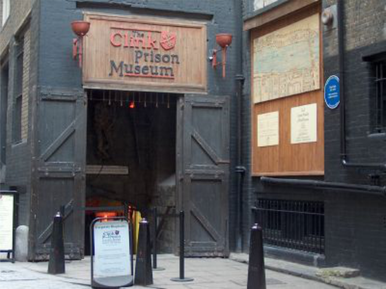 The proper name Clink has become, over time, synonymous with prison and the expression in the clink is equivalent to being in a cell. It is thought that the origin of the name is onomatopoeic and is linked to the sound produced by the closing of metal doors. The Clink Prison was part of the bishop’s palace and the name comes from Clink Liberty, an area outside the jurisdiction of the City. As it is written on the blue plaque of the facade, it worked continuously for six hundred years, until 1780. It is thought that this prison, for men and women, is the oldest in the capital; before it there were no female prisons.
The proper name Clink has become, over time, synonymous with prison and the expression in the clink is equivalent to being in a cell. It is thought that the origin of the name is onomatopoeic and is linked to the sound produced by the closing of metal doors. The Clink Prison was part of the bishop’s palace and the name comes from Clink Liberty, an area outside the jurisdiction of the City. As it is written on the blue plaque of the facade, it worked continuously for six hundred years, until 1780. It is thought that this prison, for men and women, is the oldest in the capital; before it there were no female prisons.The museum, which reconstructs life in the penitentiary, is located in the basement where there was a warehouse. The statue at the entrance depicts the gatekeeper who once collected the toll from newcomers. Further on, there is a woman dressed in rags, chained to a grate, begging passers-by. In a cell, a guard puts handcuffs on a prisoner made in the nearby furnace, while a trapper sets up a trap to catch rodents destined to be eaten. There is also a display of the gallows and the stalls used in the prison. The prisoners had to pay the guards for food, heating and clothing, and were financially assisted by relatives and friends. Craftsmen and tradespeople continued to do their work here as well in order to earn some money.
BANKSIDE AND BANKSIDE GALLERY
METRO: CANNON STREET
The Bankside runs from Blackfriars Bridge in the west to London Bridge in the east. By the 16th century, the area was outside the jurisdiction of the City and had become a place for entertainment and entertainment prohibited elsewhere, while also being associated with the literary and theatrical life. There were the dog fights with the chained bear, of which Shakespeare speaks. Today the area is very popular with tourists, attracted by the numerous art galleries of the nearby South Bank. The Millennium Bridge has made it even more accessible.
The art gallery is located at 48 Hopton Street, in close proximity to the Tate Modern and is home to the Royal Watercolour Society, the oldest existing association of watercolourists in the world, founded in 1804. The gallery has an extraordinary collection of watercolours from the 19th and 20th centuries. In the spring and autumn there are exhibitions of the work of the members, in the summer and at Christmas those of the Painter-Printmakers. Then there are the historical exhibitions and those of works by foreign artists.
THE ANCHOR PUB
34 PARK STREET
METRO: LONDON BRIDGE
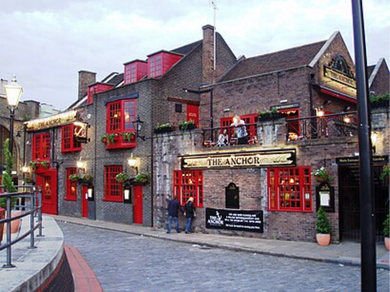 The Anchor Pub, located next to the Globe Theatre and close to the Tate Modern Gallery, is one of London’s oldest pubs. It can also be reached via the railway bridge, where part of the Cannon Street Station is located. Inside it houses several bars and a restaurant. From the roof terrace you can enjoy a great view of the Thames towards the City. The lowest and oldest part of the building, with its low beams, exposed bricks and fireplaces, is very rich in atmosphere and hosts a tea room. The beautiful Shakespeare Room, clad in warm pine wood panels, is available for ceremonies.
The Anchor Pub, located next to the Globe Theatre and close to the Tate Modern Gallery, is one of London’s oldest pubs. It can also be reached via the railway bridge, where part of the Cannon Street Station is located. Inside it houses several bars and a restaurant. From the roof terrace you can enjoy a great view of the Thames towards the City. The lowest and oldest part of the building, with its low beams, exposed bricks and fireplaces, is very rich in atmosphere and hosts a tea room. The beautiful Shakespeare Room, clad in warm pine wood panels, is available for ceremonies.THE GLOBE
BANKSIDE
METRO: LONDON BRIDGE
 The new Globe, which stands on the corner with Emerson Street, was opened in 1996 with the performance of Henry V. The building is located about two hundred meters from the place where the old theater stood in 1599, which had been built by Richard Burbage and his company of actors and which had been destroyed in 1613. The fire that had incinerated it was caused by a cannon ball fired during the performance of Henry VIII. The old Globe stood at present number 25 on Park Street and on the wall of a brasserie there is a plaque depicting Shakespeare and the landscape of Bankside that remembers him.
The new Globe, which stands on the corner with Emerson Street, was opened in 1996 with the performance of Henry V. The building is located about two hundred meters from the place where the old theater stood in 1599, which had been built by Richard Burbage and his company of actors and which had been destroyed in 1613. The fire that had incinerated it was caused by a cannon ball fired during the performance of Henry VIII. The old Globe stood at present number 25 on Park Street and on the wall of a brasserie there is a plaque depicting Shakespeare and the landscape of Bankside that remembers him.American actor and director Sam Wanamaker oversaw the reconstruction of the theatre, which lasted twenty years. The building has a circular plan and its main feature is to have a thrust stage, that is a stage that has a part in protrusion within the platea. The shows only take place from May to October because, being an open theatre, it needs good weather. Photo 125 The construction is made of aged oak planks, held together by tenon and mortise joints. Spectators sit on benches, which can accommodate about eight hundred people. The roof is covered with straw and protected from fire by fire retardant agents and sprinkler systems. The platform has a concrete floor.
I am proud to have contributed to its construction with a donation.
Bear Garden Museum - Adjacent to the Globe is the Bear Garden Museum, also founded by Sam Wanamaker in 1972. The exhibitions that are held there document the life of Southwark in Shakespeare’s time and the seventeenth-century aspect of the village.
THE SEAT OF THE FERRYMEN
BANKSIDE
METRO: LONDON BRIDGE
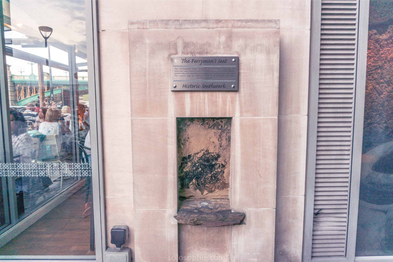 Along Bankside, near the current Globe Theatre, there is a small stone seat embedded in the wall of a modern building, used in the sixteenth century by ferrymen waiting for customers to bring across the river. At the time, the London Bridge was the only existing bridge and work for boatmen was much, even at night. The inhabitants who had gone to spend the evening on the other side of the river to watch animal fights, theatre performances or socialize with prostitutes used the ferry to return home. This seat is the only one left, but there must have been a row here to accommodate the numerous ferrymen.
Along Bankside, near the current Globe Theatre, there is a small stone seat embedded in the wall of a modern building, used in the sixteenth century by ferrymen waiting for customers to bring across the river. At the time, the London Bridge was the only existing bridge and work for boatmen was much, even at night. The inhabitants who had gone to spend the evening on the other side of the river to watch animal fights, theatre performances or socialize with prostitutes used the ferry to return home. This seat is the only one left, but there must have been a row here to accommodate the numerous ferrymen.BOROUGH MARKET
8 SOUTHWARK STREET
METRO: BOROUGH, LONDON BRIDGE
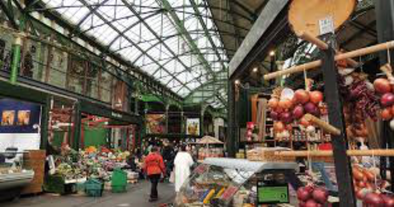 The Borough market has been around since time immemorial. It was created many centuries ago by the construction of the London Bridge by the Romans. In the Middle Ages, merchants who were not allowed to carry goods across London Bridge had begun to set up their stalls here, outside the jurisdiction of the merchant corporations of the City. On the wall of the entrance there is an old black board with golden characters that lists the rules concerning the authorizations, the plateatico, the different competences, the duties and the payments. With its more than a thousand years of existence it is the oldest fruit and vegetable market in London. The market stands out for the quality of the food sold there, even in the shops along the streets. In this market you can find both ready-to-cook and ready-to-eat foods. It is a famous market for game, but also for fish and oysters. The whole area around the market is full of quaint shops, or you can take advantage - but not too much, not to make the appearance of scroungers - free samples that are displayed on stalls. The hot Polish sausage is delicious.
The Borough market has been around since time immemorial. It was created many centuries ago by the construction of the London Bridge by the Romans. In the Middle Ages, merchants who were not allowed to carry goods across London Bridge had begun to set up their stalls here, outside the jurisdiction of the merchant corporations of the City. On the wall of the entrance there is an old black board with golden characters that lists the rules concerning the authorizations, the plateatico, the different competences, the duties and the payments. With its more than a thousand years of existence it is the oldest fruit and vegetable market in London. The market stands out for the quality of the food sold there, even in the shops along the streets. In this market you can find both ready-to-cook and ready-to-eat foods. It is a famous market for game, but also for fish and oysters. The whole area around the market is full of quaint shops, or you can take advantage - but not too much, not to make the appearance of scroungers - free samples that are displayed on stalls. The hot Polish sausage is delicious.The market stands out for the quality of the food sold there. For those who love cheese, for example, and do not want to give up the cheesy cheddar cheese wrapped in plastic from the supermarket, here at 6 Park Street, you find (the Creamery?) the store of Neal’s Yard. The cheese shapes that tower on the counters to the ceiling come from about seventy farms in England and Ireland. Matured in the special 'maturing' rooms of Bermondsey, under the brick arches of the railway, where temperature and humidity are ideal. Then, the forms are lovingly turned, brushed, sometimes washed, until they have reached the right degree of maturity (ripening?). One of the most unusual cheeses is unwashed rind cheese. Prices are quite high but, as they say, quality pays. In any case, it is worth taking a tour to see the great variety of these craft products.
In this market you can find food to cook or eat ready-made.
To be continued...
